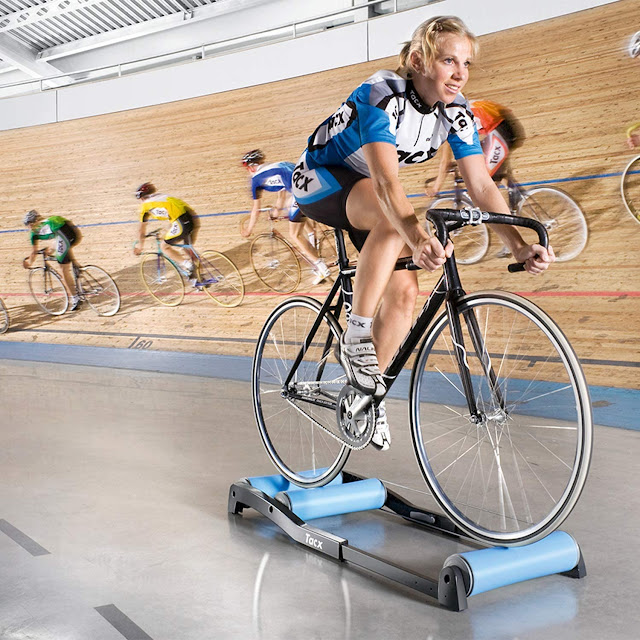The first time you see someone using a set of rollers, there’s a bit of magic; the bike and rider are perfectly balanced and working energetically, but no one is going anywhere. It looks a lot harder than it is. Novices think that riding on rollers is like doing a “track stand” where the rider stands still at a red light, but it’s not. Once in motion, the gyroscopic effect of the spinning wheels goes a long way to keeping you upright. How do you get started? This is a little more difficult, but most riders learn it quickly. You don’t have to be a bike wizard to use a set of rollers.
Most bike rollers work the same way: your bike’s rear wheel sits between two metal rollers, one of which is mechanically connected to a third roller under your front wheel. When you pedal, your wheels turn the two rear rollers, which the front roller, which turns the front wheel. There is usually no added resistance: rollers are different in this respect from trainers, which apply a load to the rear wheel.
When used correctly, rollers improve your balance, teach you to pedal smoothly and increase your confidence on the bike, while keeping you in shape during the off-season or in bad weather. We’ve selected nine of the best; pick one and let the good times roll.
How to Buy Bike Rollers
Build
Rollers are simple devices, but they are subject to many stresses and strains. Most weigh only 10 kg, but we use them by 150 kg bike-passenger combinations for long periods at high speeds. So you need to pay attention to build quality and parts availability, especially for the belt that transfers power from the rear rollers to the front rollers. Get the best you can afford.
Strength
You would want a magnetic or flywheel resistor on a set of rollers, right? Not so fast. Unlike bike simulators, which fix the bike in place and offer a wide variety of resistance, rollers improve your balance and pedaling circle. They help make you more flexible, not stronger. And unless you’re an experienced cyclist, a brief resistance can make it harder to ride safely and well. Don’t add resistance until you’re absolutely comfortable with the free-spinning rollers.
Storage and change
You need to know your wheel size and wheelbase before looking at rollers. Measure from the front axle to the rear axle; this is your wheelbase. Not all rollers will fit all bikes. And if you’re only going to use a standard road or gravel bike, don’t bother buying a one-size-fits-all set of rollers. You won’t get any benefit from it.
How we rated the bike rollers
We talked to several top amateur and professional racers in several disciplines to find out what they were looking for in a set of rollers, then solicited feedback on the various rollers available on the market to eliminate questionable choices and focus on the proven rollers. We then included rollers from multiple segments of the market; not everyone wants to spend $1,000 on an occasional use item, but some cyclists spend almost as much time on rollers as they do on the road, so it’s important to consider what would work best for those cyclists and everyone else.
1. TacX Antares
If you’re not sure if rollers are for you, the Antares will get you started. Compatible with most basic road and gravel bikes, Garmin’s entry-level product features tapered rollers that help you stay centered while riding. Deployed, it’s 4.5 feet long, but you can cut it down to about 3.5 feet.
Buy: TacX Antares
2. LiveRoll 3
If you’re ready to get serious about your gym workout, but don’t have a lot of room, Minoura’s trainers are a good choice. Made in Japan and designed with storage in mind, the Liveroll is uniquely designed for conventional 700c road and gravel bikes, but is adjustable for a wide range of frame sizes. A wooden step allows you to gain confidence by getting on and off the rollers. Expect it to last almost forever.
Buy: LiveRoll 3
3. Folding rollers
Folding Z rollers aren’t as sturdy or smooth as standard full-frame rollers, but if you live in a small apartment, they’re a vast improvement over not having a bike at all. ROCKBROS offers a wide variety of adjustments to include mountain bikes and smaller frames. The parabolic roller design allows you to stay centered, although the effect is not as strong as with conventional tapered rollers.
Buy: Folding rollers
4. Arion Mag Parabolic
Some cyclists are only happy if they have some resistance during indoor training: the Arion offers three levels of magnetic resistance in a set of ultra-compact folding rollers that can be used for both road and mountain bikes. The plastic parabolic rollers promote stability. Weighing in at 17 pounds, this folding roller set can be used almost anywhere.
Buy: Arion Mag Parabolic
5. LiveRoll R500
Large drum rollers are easier to use and we know Minoura rollers for their durability. The combination of these two qualities, for a reasonable budget, should appeal to roadies who want to put in hours during the winter. No frills, although a magnetic resistance accessory is available directly from Minoura.
Buy: LiveRoll R500
If you’re ready to ride, read these additional buying tips from the expert.
What size drum should I choose?
Most cyclists will be most satisfied with 3- to 4-inch drums, with Minoura’s 105mm “big drum” at the upper end of that range. A few manufacturers offer small 2.25-inch diameter drums, but unless you really know what you’re doing, we should avoid them.
Aluminum or plastic rollers? Parabolic, conical or straight?
When in doubt, choose straight aluminum rollers because they work best for a wide range of bikes and skill levels. Parabolic and tapered rollers bother me slightly. They have a self-centering effect - but that’s probably because I started using rollers back when straight drums were the only option. Novices should start with parabolic or conical rollers.
I want to be successful with my rollers. What should I do?
If you have a basement with support posts, consider placing your rollers next to a post. Use the pole to balance yourself at the beginning and end of each round. If that’s not possible, ask a friend to stand with you to make you more comfortable. Many cyclists learn more quickly, and with fewer incidents, by using flat pedals and non-cycling shoes. The unclipping motion can be difficult to do if you are just getting used to the rollers.
Finally, don’t overexert yourself in your first few sessions; until you really know what you’re doing, the end of the ride is when your most likely to fall off.











